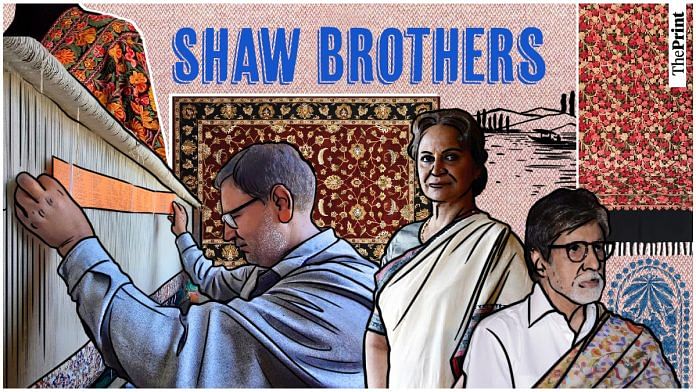For thousands of years, Indian textile craftspeople freely shared knowledge with all. With the dawn of industrialisation, followed by commercialisation and the introduction of intellectual property rights, India started losing out to foreign competitors. Fine hand-knotted carpets of Kashmir were losing out to machine-made, mass-produced carpets from China. The result was that a flourishing 1500-year-old luxury industry was pushed to the brink due to plunging demand, supply chain gaps, and master carpet weavers abandoning their traditional skill-based industry.
But with the shipping of the first geographical indication or GI-tagged Kashmir carpet consignment—which has a QR code to certify the name of the weaver, manufacturer, and raw material—to Europe in March 2022, this luxury industry found new hope. And Delhi’s Shaw Brothers, a boutique carpet and shawl brand that has been in business since the 1840s, has been celebrating it.
There are no written records, but as per spoken history, founding members of this family, including Mohiuddin Shah were traders who traveled along the Silk Road to sell carpets and shawls and purchase the finest quality raw materials like silk from Chinese traders and pure wool from Mongolian merchants. Shah’s three sons, Ghulam, Badruddin, and Merak Shah, and cousin Mubarik Shah, soon joined the business and expanded Shaw Brothers’ footprint across northern India, from the prosperous towns of Punjab to Calcutta and Murshidabad.
The upper-crust society, consisting of British officers, royalties of various principalities, and Indian business families, would patronise traders and shopkeepers selling high-end luxury goods like fine Kashmir carpets and pashmina shawls.
Srinagar to Calcutta to Delhi
Handsome profits led the Shah family to open its first shop in Srinagar’s Fateh Kadal under the brand name ‘Shaw Brothers’, which is how ‘Shah’ was pronounced by the British at that time. This was followed by another store in Calcutta’s Chowringhee in 1930. This was a time of tremendous social churning as the Indian nationalist movement grew stronger and communities from different professional mileus were trying to adjust to changing realities. During the ’40s and ’50s, affluent Indians showcased their social status through grand, intricately designed houses and fine clothing. The spartan simplicity of traditional Indian homes gave way to the exuberant flamboyance of Victorian art-inspired houses. One of the obsessions was fine Kashmiri carpets, prominently displayed as home décor, and fine shawls worn over traditional Indian wear to embellish one’s outfit.
Mohiuddin’s descendents Abdul Majid Shaw and his brothers started to work at the Delhi store around 1970. “My father (Abdul Majid Shaw) was a man of unlimited energy. He would travel to Kashmir and keep in close touch with his weavers, giving them instructions on colours, designs, and the best-quality raw materials. He would then travel back to Delhi, visiting diplomats, politicians, and big businessmen to sell high-end, customised pieces. He was a driven and enterprising businessman as well as a committed campaigner for craftsmen and village kaarigars,” says Miftah Shaw, who now runs the business with his brother Mubashir Shaw.
A gift of glamour
The Kashmiri shawl is a fashion statement across the world; global designers, fashion icons, and celebrities have adopted it through the decades. “Eminent Indian film personalities such as Amitabh Bachchan, Karan Johar, Kirron Kher, Waheeda Rehman, international stars like Catherine Deneuve, even members of the British royal family, including Prince Charles would regularly purchase fine Jamawar and Pashmina shawls from us. In fact, one of the biggest boosts we got in our business was when a celebrated Japanese collector, Ogawa, displayed his Kashmir collection at an art gallery in Ginza, Tokyo, in 1975. This opened the floodgates for purchases from Japan. Now we need a similar opportunity and similarly passionate patrons for Kashmiri carpets,” says Mubashir Shaw.
The Kashmiri carpet was once one of the most popular and prized gift items in India among the elite, from heads of State to high-end tourists. But now, even at Kashmiri shops in five-star hotels, the sale of these carpets is sluggish. “This is because a normal customer is not informed about the difference between a machine-made product and a hand-knotted carpet made by a master kaarigar. A lot of our carpet master craftspeople are actually women working in the cottage industry at home. They work for months to produce one superb piece with fine-quality wool and silk. But if they do not get a good price for their effort, they will leave this work, and this skill will be lost forever,” says Mubashir Shaw, looking intently at the new batch of carpets at his showroom.
Shaw Brothers’ new and transformative business idea to make the Kashmiri carpet attractive again is to propose it as a piece of art to be displayed on walls. Combined with the GI tag, this clever reimagination can possibly make the Kashmiri carpets fly again. Hopefully.
This article is a part of a series called BusinessHistories exploring iconic businesses in India that have endured tough times and changing markets. Read all articles here.
(Edited by Humra Laeeq)




